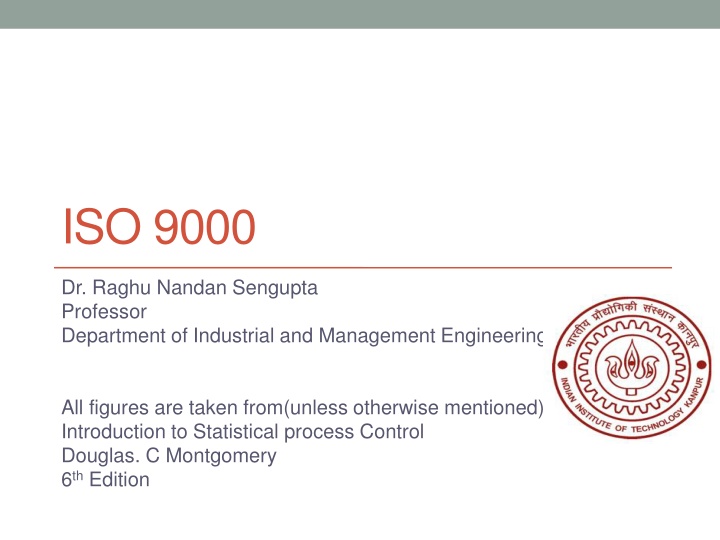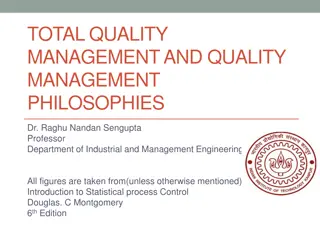
Introduction to ISO 9000 Standards and Quality Management
Explore the world of ISO 9000 standards and quality management with insights from Dr. Raghu Nandan Sengupta, covering topics such as Statistical Process Control, Total Quality Management, and the importance of precision in gauge capability. Learn about the history of ISO, its standards, and the process of getting ISO certified.
Download Presentation

Please find below an Image/Link to download the presentation.
The content on the website is provided AS IS for your information and personal use only. It may not be sold, licensed, or shared on other websites without obtaining consent from the author. If you encounter any issues during the download, it is possible that the publisher has removed the file from their server.
You are allowed to download the files provided on this website for personal or commercial use, subject to the condition that they are used lawfully. All files are the property of their respective owners.
The content on the website is provided AS IS for your information and personal use only. It may not be sold, licensed, or shared on other websites without obtaining consent from the author.
E N D
Presentation Transcript
ISO 9000 Dr. Raghu Nandan Sengupta Professor Department of Industrial and Management Engineering All figures are taken from(unless otherwise mentioned): Introduction to Statistical process Control Douglas. C Montgomery 6thEdition
TQM I Raghu N. Sengupta Lecture # 34
Precision to Tolerance Ratio Precision to Tolerance Ratio Values of the estimated ratio P/T of 0.1 or less often are taken to imply adequate gauge capability.
ISO The International Standards Organization (founded in 1946 in Geneva, Switzerland), known as ISO, has developed a series of standards for quality systems. The first standards were issued in 1987. The current version of the standard is known as the ISO 9000 series. It is a generic standard, broadly applicable to any typeof organization, and it is often used to demonstrate a supplier s ability to control its processes. ISO 9000 is also an American National Standards Institute and an ASQ standard.
Three standards of ISO 9000 ISO 9000:2000 Quality Management System Fundamentals and Vocabulary ISO 9001:2000 Quality Management System Requirements ISO 9004:2000 Quality Management System Guidelines for Performance Improvement
8 clauses of ISO 9000 (1) Scope (2) Normative References (3) Definitions (4) Quality Management Systems (5) Management Responsibility (6) Resource Management (7) Product (or Service) Realization (8) Measurement, Analysis, and Improvement.
Getting ISO certified To become certified under the ISO standard, a company must select a registrar and prepare for a certification audit by this registrar. There is no single independent authority that licenses, regulates, monitors, or qualifies registrars Preparing for the certification audit involves many activities, including (usually) an initial or phase I audit that checks the present quality management system against the standard. This is usually followed by establishing teams to ensure that all components of the key clause are developed and implemented, training of personnel, developing applicable documentation, and developing and installing all new components of the quality system that may be required. If the company is certified, then periodic surveillance audits by the registrar continue, usually on an annual (or perhaps six-month) schedule.
Supplier quality issues Many organizations have required their suppliers to become certified under ISO 9000, or one of the standards that are more industry-specific. Examples of these industry-specific quality system standards are AS 9100 for the aerospace industry; ISO/TS 16949 and QS 9000 for the automotive industry; and TL 9000 for the telecommunications industry. Many components of these standards are very similar to those of ISO 9000.
Major Focus Much of the focus of ISO 9000 (and of the industry-specific standards) is on formal documentation of the quality system; that is, on quality assurance activities Organizations usually must make extensive efforts to bring their documentation into line with the requirements of the standards Many of the third-party registrars, auditors, and consultants that work in this area are not sufficiently educated or experienced enough in the technical tools required for quality improvement or how these tools should be deployed Therefore, they concentrate largely on the documentation, record keeping, and paperwork aspects of certification. There is also evidence that ISO certification or certification under one of the other industry-specific standards does little to prevent poor quality products from being designed, manufactured, and delivered to the customer 1999 2000, there were numerous incidents of rollover accidents involving Ford Explorer vehicles equipped with Bridgestone/Firestone tires
A WORD OF CAUTION It has been estimated that ISO certification activities are approximately a $40 billion annual business, worldwide. Much of this money flows to the registrars, auditors, and consultants. This amount does not include all of the internal costs incurred by organizations to achieve registration, such as the thousands of hours of engineering and management effort, travel, internal training, and internal auditing. It is not clear whether any significant fraction of this expenditure has made its way to the bottom line of the registered organizations. Furthermore, there is no assurance that certification has any real impact on quality
The Malcolm Baldrige National Quality Award The Malcolm Baldrige National Quality Award (MBNQA) was created by the U.S. Congress in 1987 It is given annually to recognize U.S. organizations for performance excellence. Awards are given to organizations in five categories: manufacturing, service, small business, health care, and education. The award is administered by NIST (the National Bureau of Standards and Technology). The criteria are directed towards results, where results are a composite of customer satisfaction and retention, market share and new market development, product/service quality, productivity and operational effectiveness, human resources development, supplier performance, and public/corporate citizenship
Further References http://www.iso.org/iso/iso_9000 http://asq.org/learn-about-quality/iso- 9000/overview/overview.html https://en.wikipedia.org/wiki/ISO_9000

